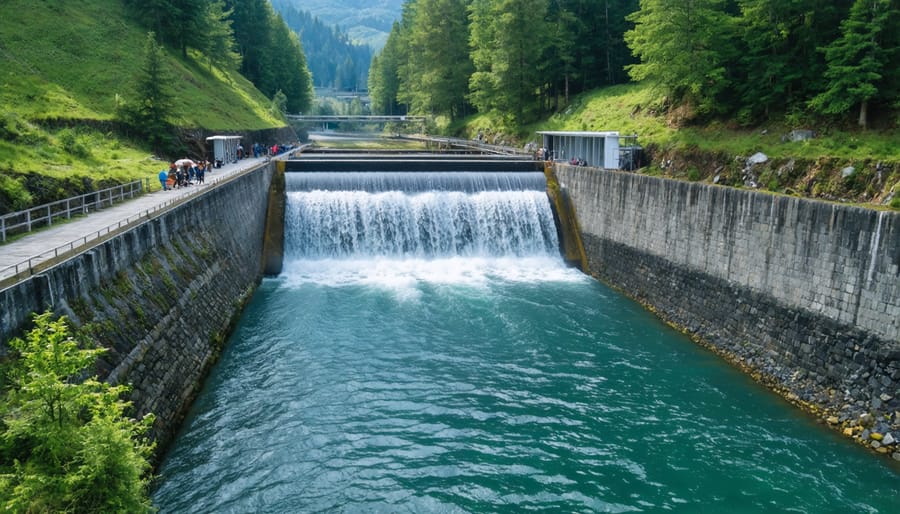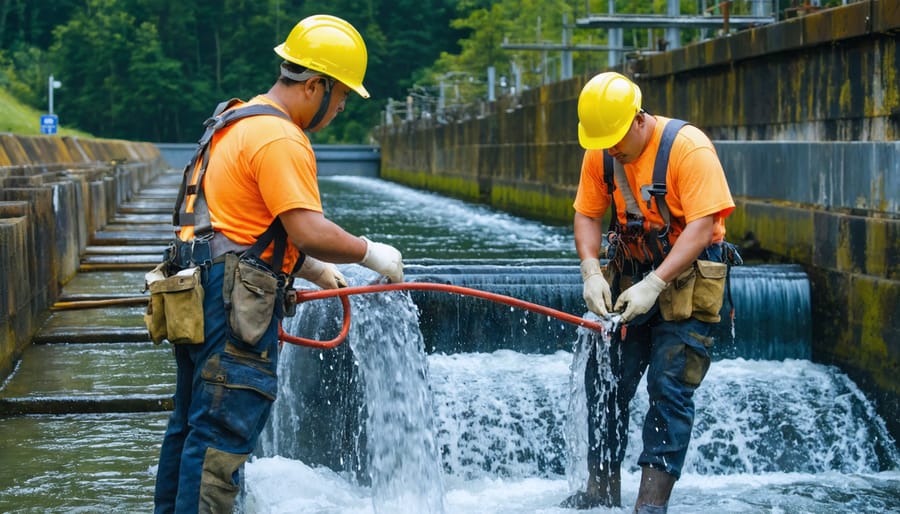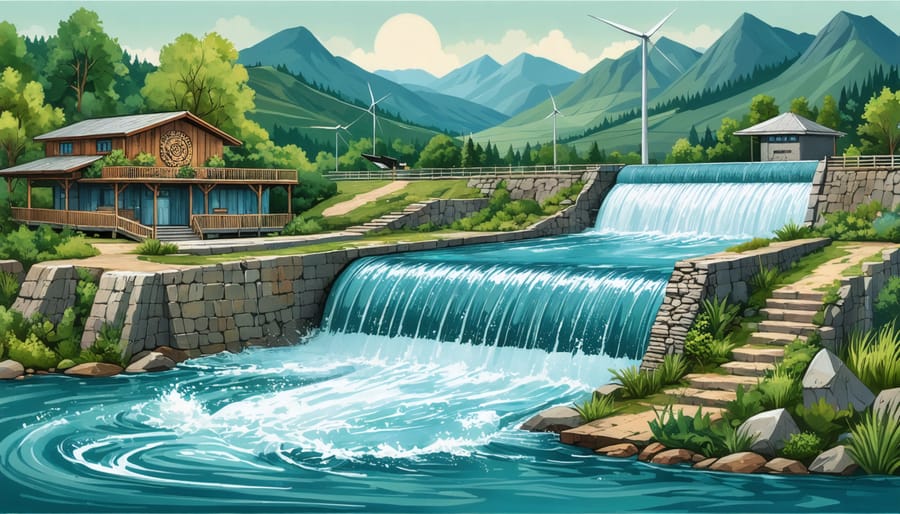Harnessing the power of flowing water has transformed economies and communities across Australia, generating far more than just electricity. As our nation navigates the transition to renewable energy, hydropower stands out as a cornerstone of sustainable economic development, delivering over $3.5 billion in annual benefits to regional communities. From creating thousands of skilled jobs to stabilizing electricity prices and supporting agricultural productivity, hydropower installations serve as powerful catalysts for local economic growth.
In remote Indigenous communities, hydropower projects have emerged as game-changers, fostering self-sufficiency while honoring traditional connections to land and water. These initiatives not only provide reliable, clean energy but also create lasting employment opportunities, support Indigenous-owned businesses, and fund essential community services. The Snowy Hydro Scheme, Australia’s largest renewable energy project, exemplifies how hydropower infrastructure can drive multi-generational economic prosperity while maintaining ecological balance.
As climate change intensifies the need for reliable renewable energy, hydropower’s ability to deliver both environmental and economic benefits positions it as a crucial investment in Australia’s sustainable future. This proven technology offers a unique combination of grid stability, flood control, water security, and economic stimulus that few other energy sources can match.
Indigenous-Led Hydropower: A New Economic Frontier

Traditional Water Management Meets Modern Technology
In remote Australian communities, the fusion of traditional water management practices with modern hydropower technology is revolutionizing energy production. Indigenous communities have maintained sophisticated water management systems for tens of thousands of years, understanding intricate seasonal patterns and sustainable water flow management.
Today, this ancestral knowledge is proving invaluable in optimizing hydropower installations. At sites like the Ord River Hydro plant in Western Australia, Indigenous water experts work alongside engineers to determine optimal dam locations and water release schedules that respect both cultural values and power generation needs.
This collaborative approach has led to more efficient project designs, reduced environmental impacts, and improved community acceptance. Indigenous rangers contribute to environmental monitoring, helping maintain water quality and ecosystem health while ensuring consistent power generation. Their deep understanding of local weather patterns and water cycles has also enhanced flood management and drought resilience, making hydropower systems more reliable and cost-effective.
The marriage of traditional knowledge with modern technology demonstrates how cultural wisdom can drive innovation in renewable energy, creating sustainable solutions that benefit both the environment and local communities.
Community Ownership Models
Indigenous communities across Australia are increasingly embracing innovative community-owned energy projects through various ownership models that enhance economic sovereignty while preserving cultural values. The cooperative ownership structure has proven particularly successful, allowing communities to maintain direct control over their hydropower resources while sharing benefits equitably among members.
The trust model, widely adopted by Traditional Owner groups, ensures long-term sustainability by reinvesting profits into community development initiatives. This approach has demonstrated remarkable success in places like the Kimberley region, where Indigenous-owned hydropower projects provide both clean energy and sustainable income streams.
Joint venture partnerships between Indigenous corporations and established energy companies offer another viable pathway, combining traditional knowledge with technical expertise. These arrangements typically include skills training programs, employment guarantees, and profit-sharing agreements that maximize community benefits.
Many communities have also established social enterprises around their hydropower assets, creating additional revenue streams through eco-tourism and educational programs. This holistic approach ensures that economic benefits extend beyond direct energy generation, supporting broader community development goals while maintaining cultural connections to land and water resources.
Direct Economic Benefits
Revenue Generation and Profit Sharing
Hydropower facilities generate revenue through multiple streams, creating a robust economic model that benefits various stakeholders. The primary income source comes from electricity sales to the grid, with many Australian facilities securing long-term power purchase agreements that ensure steady cash flow. During peak demand periods, hydropower plants can command premium prices, significantly boosting their revenue potential.
The profit-sharing structure typically involves multiple beneficiaries, including project developers, local communities, and government entities. In successful projects like the Snowy Hydro scheme, revenues are distributed through direct payments, community development funds, and infrastructure improvements. Local councils often receive rates and charges, while state governments benefit from licensing fees and royalties.
Indigenous communities participating in hydropower projects can negotiate benefit-sharing agreements that include direct financial returns, employment opportunities, and funding for cultural programs. For instance, some projects allocate a percentage of annual revenue to Indigenous-led initiatives, supporting both economic development and cultural preservation.
Innovative revenue models are emerging, combining traditional electricity sales with environmental services. Carbon credit trading, water management services, and recreational facility fees provide additional income streams. Many modern hydropower facilities also integrate tourism opportunities, creating supplementary revenue through visitor centers and guided tours, making the most of these impressive engineering achievements while educating the public about renewable energy.

Employment and Skills Development
Hydropower projects serve as powerful engines for job creation and skill development across Australia’s renewable energy sector. From initial construction to ongoing operations, these facilities generate diverse employment opportunities that benefit local communities and boost regional economies.
During the construction phase, major hydropower projects typically employ hundreds of workers, including engineers, construction specialists, environmental consultants, and support staff. The Snowy 2.0 project, for instance, has created over 2,000 direct jobs and thousands more indirect positions throughout its supply chain.
The long-term operational phase provides stable, skilled employment opportunities in areas such as facility maintenance, environmental monitoring, and power generation management. These roles often come with comprehensive training programs that upskill local workforce and create career pathways in the renewable energy sector.
Indigenous communities particularly benefit from hydropower projects through targeted employment programs and specialised training initiatives. Many projects incorporate traditional knowledge and cultural practices into their operations, creating unique opportunities for Indigenous workers to combine traditional skills with modern renewable energy expertise.
The industry also supports apprenticeship programs and partnerships with technical institutions, fostering the next generation of renewable energy professionals. These initiatives help build Australia’s capacity in clean energy technology while ensuring a sustainable workforce for the future.
Beyond direct employment, hydropower projects stimulate job growth in related sectors such as tourism, environmental services, and local business support services, creating a multiplier effect that strengthens regional economies.
Ripple Effects on Local Economies
Supporting Industries and Services
Hydropower developments create a vibrant ecosystem of supporting industries and services that extend far beyond the dam walls. Engineering firms, environmental consultants, and construction companies flourish in regions with active hydropower projects, creating sustainable job opportunities for local communities.
Maintenance and operational services form a crucial backbone of the industry, with specialized technicians and service providers establishing long-term business relationships with hydropower facilities. Local manufacturers supply essential components and spare parts, while technology companies develop innovative monitoring and control systems to optimize plant performance.
Tourism and recreation services have emerged as unexpected beneficiaries, with dam sites becoming popular destinations for water sports, fishing, and eco-tourism. In regions like the Snowy Mountains, these activities contribute significantly to local economies, supporting hospitality businesses, tour operators, and retail outlets.
Environmental monitoring and research organizations also thrive alongside hydropower developments. These specialists conduct regular assessments, maintain water quality, and ensure the sustainable management of aquatic ecosystems. Indigenous-owned enterprises often participate in environmental management, combining traditional knowledge with modern practices.
The transportation sector benefits through improved waterway management and navigation services, while agricultural businesses leverage regulated water flows for irrigation. Educational institutions have developed specialized training programs, creating pathways for future industry professionals and contributing to knowledge sharing within the sector.
This diverse network of supporting industries creates a multiplier effect, strengthening regional economies and fostering innovation in sustainable energy development.
Infrastructure Development
The development of hydropower projects brings significant improvements to local infrastructure, creating lasting benefits for communities. When hydropower facilities are constructed, the surrounding regions often experience substantial upgrades to road networks, improving accessibility and transportation efficiency. These enhanced connections benefit local businesses, residents, and tourism operators alike.
Water management infrastructure sees marked improvement through hydropower development. Modern reservoir systems not only generate electricity but also provide reliable water supply for agriculture and domestic use. In rural Australian communities, these improvements have transformed previously water-stressed regions into thriving agricultural zones.
The establishment of hydropower facilities typically catalyses the modernisation of electrical grid infrastructure. This upgraded power network delivers more reliable electricity to homes and businesses, reducing outages and supporting economic growth. Communities near hydropower projects often benefit from improved telecommunications infrastructure, as power stations require robust communication systems that can be extended to serve local needs.
Educational and healthcare facilities in these regions frequently receive upgrades to support the incoming workforce and their families. This creates a positive ripple effect, attracting skilled professionals and encouraging young families to settle in the area. The development of recreational facilities around reservoirs, including parks and water sports amenities, adds another layer of community infrastructure that boosts tourism and enhances local quality of life.
Environmental and Cultural Sustainability
Balancing Progress with Traditional Values
The successful integration of hydropower projects with traditional values demonstrates how economic progress and cultural heritage can coexist harmoniously. Many Indigenous communities have shown leadership in balancing development with cultural preservation, establishing frameworks that ensure economic benefits flow while sacred sites and traditional practices remain protected.
In the Snowy Mountains region, collaborative approaches between project developers and Traditional Owners have created models for respectful development. These partnerships include cultural heritage management plans, employment programs that incorporate traditional knowledge, and ongoing consultation processes that give Indigenous communities a voice in project decisions.
The key lies in viewing cultural preservation not as a barrier to development, but as an essential component of sustainable progress. Communities have implemented innovative solutions, such as designing water flow patterns that protect cultural sites while maintaining power generation efficiency. This approach has resulted in projects that deliver both economic returns and cultural benefits, proving that progress doesn’t require compromising traditional values.
These successful examples serve as blueprints for future developments, showing how careful planning and genuine respect for cultural heritage can create lasting economic opportunities while strengthening traditional connections to country.

Long-term Environmental Stewardship
Sustainable hydropower operations demonstrate a profound commitment to long-term environmental protection while delivering consistent economic benefits. Through Indigenous environmental stewardship practices, modern hydropower facilities incorporate traditional knowledge with cutting-edge monitoring systems to maintain healthy river ecosystems.
Australian hydropower operators have pioneered innovative approaches to watershed management, including fish-friendly turbine designs and environmental flow regimes that mimic natural river patterns. These practices ensure the continued health of aquatic ecosystems while maintaining reliable power generation. Many facilities have established dedicated environmental trust funds, reinvesting a portion of their revenue into conservation initiatives and habitat restoration projects.
The industry’s commitment to environmental stewardship extends beyond regulatory compliance, with operators actively participating in research partnerships with universities and environmental organizations. These collaborations have led to breakthrough technologies in sediment management and water quality maintenance, creating positive ripple effects throughout the river system. By balancing power generation with ecosystem preservation, hydropower facilities are proving that long-term economic success and environmental protection can work hand in hand.
Future Opportunities and Challenges
The future of hydropower in Australia holds immense promise, with potential for both expansion and innovation. As our nation moves towards renewable energy targets, hydropower is positioned to play an increasingly vital role in our energy mix. Current projections suggest that hydropower capacity could increase by up to 30% by 2040, particularly through the development of small-scale and run-of-river projects.
Pumped hydro storage presents a particularly exciting opportunity, with several major projects already in development. These facilities can help solve the intermittency challenges of other renewable energy sources, effectively acting as giant batteries that store excess solar and wind power for later use.
However, the path forward isn’t without its challenges. Climate change impacts, including prolonged droughts and changing rainfall patterns, could affect water availability for hydropower operations. Environmental considerations, particularly regarding river ecosystems and fish populations, require careful management and innovative solutions.
Infrastructure costs remain a significant hurdle, especially for new large-scale projects. While operational costs are low, the initial investment required can be substantial. This challenge is driving innovation in construction methods and project financing models.
Community engagement and Indigenous partnerships will be crucial for future development. Successful projects will need to demonstrate clear benefits for local communities while respecting cultural heritage and environmental values.
Despite these challenges, technological advancements are opening new possibilities. Modern turbine designs are more fish-friendly and efficient, while digital technologies are improving operational performance and reducing maintenance costs. With the right approach to addressing these challenges, hydropower’s economic benefits can continue to grow while supporting Australia’s renewable energy future.
The economic benefits of Indigenous hydropower initiatives extend far beyond mere financial returns, creating a ripple effect of positive change throughout communities. These projects demonstrate how traditional knowledge and modern renewable energy technology can work in harmony to create sustainable economic opportunities. By supporting Indigenous-led hydropower developments, we invest in a future that honours cultural heritage while advancing Australia’s clean energy goals.
The success stories we’ve explored show that hydropower projects can provide stable income streams, create local employment, and foster skill development within Indigenous communities. These benefits multiply as communities reinvest profits into education, healthcare, and cultural programs, strengthening their economic independence and self-determination.
Now is the time to take action. Whether you’re a policymaker, investor, or community member, supporting Indigenous hydropower initiatives means backing a proven path to economic prosperity that respects both people and planet. By partnering with Indigenous communities, sharing knowledge, and advocating for supportive policies, we can help scale these successful models across Australia. Together, we can build an energy future that generates wealth, preserves culture, and protects our precious water resources for generations to come.

